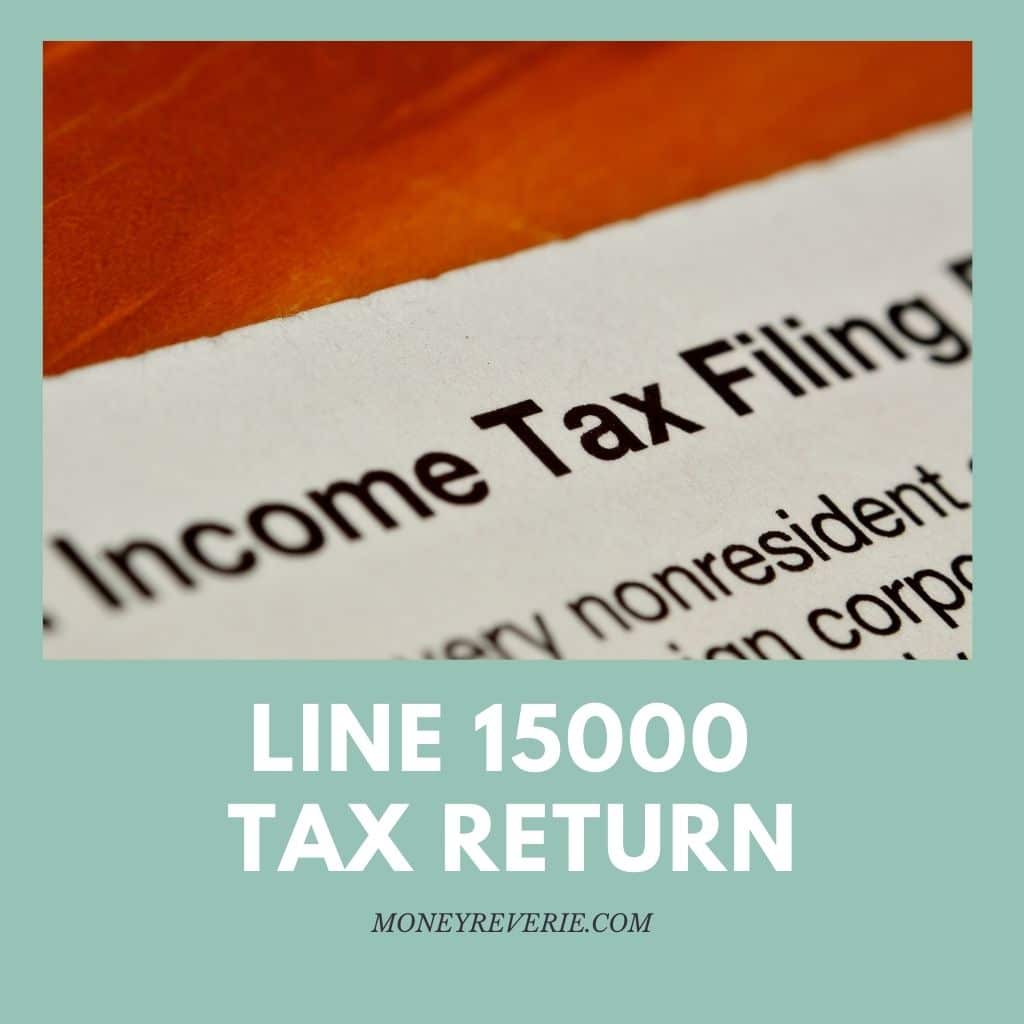Did you just file your taxes and receive your Notice of Assessment, feeling overwhelmed by all those numerous line numbers staring back at you, especially Line 15000, as you wonder what they all mean?
In simple terms, Line 15000 on your tax return represents your total income before deductions, often called gross income. This includes all your wages or salary from your T4 slip, along with any other income from different sources.
In this blog post, we will extensively explore Line 15000 on tax returns, show you how to calculate it, where to find Line 15000 on your tax return, and the implications of not filing it.
Key Takeaways
- Line 15000 was formerly known as line 150.
- Line 15000 represents your total income before any deductions, including wages, salaries, and income from any other sources.
- Line 15000 is mostly used by banks, loan officers, the Canada Revenue Agency, and Lawyers.
- There are implications for late payments or failing to file your Line 15000 tax return.
What is Line 15000 On Tax Return?
Where is Line 15000 on Tax Return?
When you are filing a tax return in Canada, you can find your Line 15000 in a few different locations, including:
- Your Tax Return on your Summary Page (One of the beginning pages)
- Notice of Assessment (From the CRA)
- Logging into your CRA MyAccount
- Logging into your Accufile Account (On page 2)
- Calling CRA at 1-800-959-8281
How Do I Calculate Line 15000 on My Tax Return?
To calculate your total income for your tax return, you must consider all the different sources of income you have. You need to sum up all your income under Part 2 of your tax return to calculate Line 15000 on your tax return.
To ensure accuracy, it’s essential to include the following common sources of income when calculating Line 15000 – Total Income. Here are the major incomes you must add (if you have) when calculating your tax return:
- Employment Income (Line 10100): This refers to the Statement of Remuneration on your T4 slip.
- Employment Income Not Included Your T4 Slip (Line 10400): This includes gratuities, tips and bonuses not reported on your T4 slip.
- OAS Benefits (Line 11300): OAS stands for Old Age Security. This benefit, OAS allowance, and Guaranteed Income Supplement (GIS) constitute your total income.
- CPP or QPP Benefits (Line 11400): This refers to your Canada Pension Plan (CPP) or Quebec Pension Plan (QPP) benefits.
- Other Pensions and Superannuation (Line 11500): Your Line 15000 tax return includes other pensions and superannuation.
- Elected Split-Pension Amount (Line 11600): Elected Split-Pension refers to the money you receive upon dividing the pension of your spouse or common-law partner.
- Employment Insurance (EI) and Other Benefits (Line 11900): Line 11900 refers to your employment insurance and other benefits reported on your T4E slip.
- Taxable Amount of Dividends from Canadian Corporations (Line 12000): This refers to the dividend income you received from a corporation upon holding a share or a whole corporation.
- Interest and Other Investment Income (Line 12100): Your interest and other investment income, such as the T3 slip, are also included in the Line 15000 tax return.
- Net Partnership Income (Line 12200): Your net income from a limited or non-active partnership also constitutes your total income (Line 15000 tax return).
- Registered Disability Savings Plan Income (Line 12500): Your Registered Disability Savings Plan (RDSP) income reported on T4A is also included in your total return.
- Rental Income (Line 12600): Any income you received from your rented property listed under Line 12600 adds to your total income.
- Taxable Capital Gains (Line 12700): This refers to any profit you make from selling a property or investment.
- Support Payments Received (Line 12800): Any taxable amount you received from spousal support and child support is also considered part of your income, hence added to your Line 15000 tax return.
- RRSP Income (Line 12900): This refers to your Registered Retirement Savings Plan (RRSP) income.
Other Income (Line 13000): Other income refers to the rest of your income not listed in any tax return or tax slip. - Artists, Fellowships, Scholarship, Bursaries, and Project Grants (Line 13010): This refers to any taxable income from scholarships, grants, fellowships, or artist and bursary income.
- Self-Employment Income (Lines 13500 to 14300): Your income from a business, fishing, farming, professional work or commission is calculated in your total income.
- Worker’s Compensation Benefits, Social Assistance and Net Federal Supplements (Line 14700): Finally, your income from Worker’s Compensation Benefits (Line 14400), Social Assistance (Line 14500) and Net Federal Supplements (Line 14600) also determine your total income.
However, you’re not required to include the above sources of income more than once in your Line 15000 tax return. You may need to attach evidence to most of these sources of income with forms and schedules.
Non-Taxable Incomes in Your Line 15000 Tax Return
The following incomes are not included in your taxable income, even though you are required to report them:
- Canada Child Benefit (CCB) and GST/HST
- Government compensation for vehicle accidents or crime victims
- Most inheritances and gifts
- Disability or death benefit
- Strike payment
- Workers’ compensation benefits
- Most lottery winnings
- Scholarships and bursaries for elementary and secondary school
- Some bursaries, scholarships and fellowships for post-secondary school
- Tax-free savings account (TFSA) income
Who is Required to File a Line 15000 Tax Return in Canada?
Not every Canadian is expected to file the Line 15000 tax return. Those required to file this tax line are people who:
- Have income tax on the previous tax year.
- Have to pay part of their Old Age Security or Employment Insurance benefits.
- Disposed or sold their properties.
- Registered for the Canada Pension Plan (CPP)
- Didn’t repay an RRSP-qualified withdrawal
- Have capital gains reserves or taxable capital gain.
- Split their pension income between their spouses or common-law partners.
- Receive allowances (such as grants and scholarships).
- Receive worker’s compensation and Universal Child Care.
- Benefit from social assistance programs
- Receive federal supplements.
However, if you’re employed, your employer must deduct and send tax payments for each paycheque to the Canada Revenue Agency. You may have to pay more tax if your employer did not deduct enough from your employment income throughout the year.
But you will get your money back upon tax filing if your employer deducts more than the required amount from your employment income. Even if you earn income from other sources, you must include it when filing your tax return.
Overall, filing your Line 15000 tax return is one of the requirements for the following benefits:
- RRSP contributions
- Child Tax Benefit
- Goods and Services Tax, Harmonized Sales Tax (GST/HST) credit
- Tuition or educational benefit (such as RESP)
Who Typically Asks for Line 15000?
Your Line 15000 can be requested by the IRS, financial institutions, or other entities. They have different reasons for wanting to see your total income, like income verification, identity verification, or to help with credit.
Here are some examples of who may ask for a Line 15000 tax return:
- Financial Purposes (Banks, Loans, Mortgage, Lenders, etc.)
- Legal Purposes (Lawsuits, Child or Spousal Support)
- Canada Revenue Agency (They usually ask for line 15000 to verify your identity and income)
- Federal Grants (Grants for School, Financial Student Assistance)
What are the Implications of Late Payment or Not Filing the Line 15000 Tax Return?
Understanding the implications of late payment or failure to file your Line 15000 tax return is crucial to avoid penalties and legal consequences.
The Income Tax Act imposes penalties on individuals who fail to submit their tax returns when obligated or provide false information on their returns.
Under-reporting income by omitting key information can also lead to penalties. Criminal charges may be filed in severe intentional fraud or tax evasion cases.
Penalties for Late Tax Filing or UnderPayment
For late tax filing or underpayment, penalties can include a 5% penalty of the amount owed and an additional 1% per month if it remains unpaid for up to a year.
Additionally, daily interest charges accumulate on any unpaid taxes. If you cannot make a one-time payment, you can contact the Canada Revenue Agency (CRA) to discuss a payment plan.
In cases where it is discovered that you owe more than initially calculated, you can explore the option of filing an appeal.
Penalties for Tax Evasion and Fraud
Tax evasion and fraud carry more severe penalties. Failure to file your tax return can result in summary criminal charges under the Income Tax Act.
In Canada, evading taxes can lead to substantial fines and even imprisonment. If found guilty of tax evasion due to intentionally misleading or misrepresenting the CRA, you may be charged up to 200% of the evaded taxes.
Furthermore, tax evasion and fraud can lead to a prison sentence of up to two years. These offences fall under the purview of criminal law and the Criminal Code of Canada, resulting in a criminal record and potential impact on future loan qualifications due to failure to pay.
It is important to note that the CRA can seize wages, assets, and other property until the full payment of taxes, interest, and penalties is made.
Voluntary Disclosures Program
The CRA offers the Voluntary Disclosures Program (VDP), which allows individuals to come forward and disclose incorrect or incomplete information on past tax returns without incurring penalties.
While tax debt and interest still need to be paid, the VDP can sometimes provide partial interest relief, reducing the financial burden and avoiding prosecution.
Why Did Line 150 Change to Line 15000?
The Canada Revenue Agency (CRA) has significantly changed line numbers on tax returns to accommodate the increased number of lines. This adjustment was necessary due to the expansion of the T1 schedule, which has grown from 4 to 8 pages over time. The new format aims to provide individuals with a more convenient way to locate specific information on their tax returns.
The line numbers have transitioned from three to five digits to accommodate the increased complexity and diversity of taxes in Canada. This change creates room for better organisation and categorisation of the information provided on the tax return.
With these improvements, taxpayers can easily navigate their tax returns and locate the necessary details. The updated line numbering system reflects the CRA’s commitment to enhancing the tax filing experience for individuals across Canada.
Final Thoughts on Line 15000 Tax Return
I hope this article has shed light on the importance of the Line 15000 Tax Return. Understanding this key aspect of your tax filing process is essential to avoid penalties and legal complications.
Remember, when it comes to filing your taxes especially Line 15000, accuracy is key. Ensure you include all the relevant sources of income and adhere to the guidelines set forth by the Canada Revenue Agency. Don’t hesitate to contact tax professionals or utilise trusted tax software like TurboTax to navigate the complexities easily.
Now that you’re knowledgeable, it’s time to take action. Grab those receipts, organize your documents, and tackle your Line 15000 Tax Return like a pro. The sooner you get started, the sooner you can enjoy peace of mind knowing that your taxes are in order.
FAQs on Line 15000 Tax Return
Where is Line 15000 on Tax Return?
Line 15000 is the total of your income before tax deductions. So you have to add your total income before tax deduction to determine it.
Is Line 150 the Same as Line 15000?
Yes, Line 15000 was formerly known as Line 150. But despite the name change, Line 150 means the same thing as Line 15000.
What is Considered Self Employment Income in Canada?
Self-employment in Canada refers to any business you run alone or in partnership. This could be a profession, business, fishing, farming, commission sales etc.









